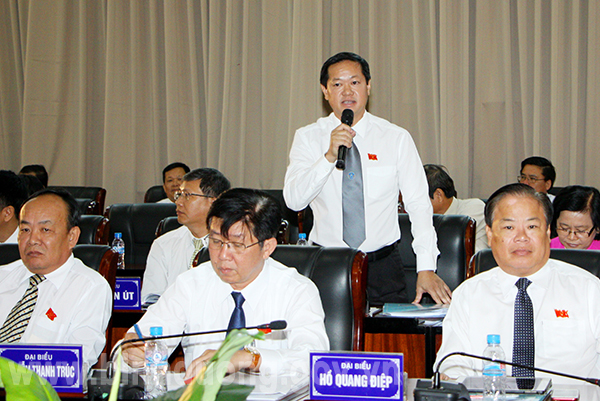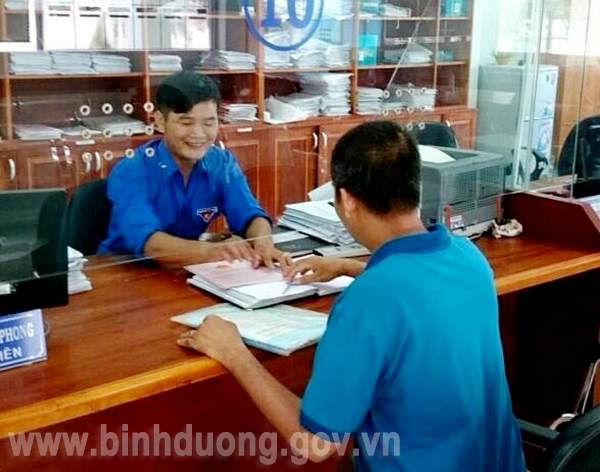Public office modernization
Delegate Nguyen Van Hien Phuc (Ben Cat District Delegation) interrogated about modernization of public offices and information technology application in state agencies. Mr. Mai Son Dung responded that, in recent years, the province has invested in construction and repair of administrative offices in the province more clean and beautiful, investment in synchronization of working equipment. Especially, the operation of Binh Duong Province Administration Center has facilitated the transaction activities of people and organizations, contributing to creating image and position of civilized and modern administrative agencies of the province.

Delegate Nguyen Van Hien Phuc (Representative of Ben Cat District) interrogated about modernization of public offices. Photo: Quoc Chien
Implement e-government program and Public Administration Reform Program for 2016-2020, the application of information technology in the work process of each administrative agency, between state administrative agencies together and in transactions with organizations and individuals continue to be promoted. This has contributed to improving work efficiency in solving administrative procedures, creating a transparent and modern administrative environment, contributing to staffs downsizing.
However, the application of information technology in state administrative agencies has some difficulties such as: the level of information technology of some civil servants is still limited, and the habit of using paper documents when solving work; the legality of electronic documents is not high when they exist in parallel with paper documents; people do not have the habit of using online services to carry out administrative transactions… Therefore, parallel with the process of modernizing the administration, it is necessary to train and foster the contingent of civil servants who have good moral qualities, professional expertise and professional activities to meet the requirements of work, at the same time, combined implementation of streamlining officials and civil servants have limited capacity.
Receiving and returning administrative procedure settlement results via Post office
Answer question of Representative Tran Thanh Liem (Bau Bang District Delegation) on receiving and returning administrative procedures via Post office, Director of Department of Home Affairs said, from 2013, Binh Duong province is one of the first localities to pilot receive and return administrative procedures via Post office. To implement Decision 45 of the Prime Minister and continue the results achieved, Department of Home Affairs, Department of Information and Communication, Department of Justice and Provincial Post Office, after reviewing, it advised the People's Committee to promulgate the Plan No.1593/QD-UBND dated June 20th 2017 on the plan to deploy the service of receiving and return administrative procedures settlement results via Post for the period of 2017-2020. Accordingly, 975 administrative procedures are under the jurisdiction of Public Administration Center and People's Committees of District and Commune will be implemented through 70 post offices of the commune-level cultural post system in 9 districts, towns and cities.

Receiving and returning administrative procedures settlement results through Post offices to contribute to administrative reform
In 2017, piloting the implementation of 90 administrative procedures (78 administrative procedures at public administrative centers and 12 administrative procedures in localities) and returning 975 administrative procedures through Post offices. At the end of each year, preliminary review will be carried out and plans for expansion will be carried out each year. By the year 2020, all 975 administrative procedures will be received and returned through post office systems of Binh Duong Post Office.
Expected, after a period of preparation of infrastructure facilities and equipment of Provincial Post Office, by the end of July 2017, local people and businesses can choose to directly visit 70 post offices in the province to submit application file and request results to be sent to their home or business address instead of going to state administrative agencies to solve administrative procedures. This helps save time, cost, bring satisfaction to people and businesses in Binh Duong province.
Continue to implement the staff downsizing scheme
Delegate Nguyen Xuan Ngan (Tan Uyen town delegation) interrogated results of staff downsizing in the province over time under Resolution No.39-NQ/TW. Mr. Mai Son Dung said, on the basis of staff downsizing scheme approved by the PPC, the agencies and units shall draw up plans to implement annual payroll streamlining. As a result, in 2015, Binh Duong has streamlined 184 cases; in 2016, the streamlining of 778 cases and the first 6 months of 2017, 53 cases have been streamlined.
To implement the management and use of payroll associated with implementation of the staff downsizing scheme for 2015-2021 period of the province, Every year, agencies, organizations and units shall draw up the average reduction plan of 1.5-2%. Based on the Decision No. 3925/QĐ-BNV dated October 25th 2016 of the Ministry of Home Affairs, the PPC has submitted to the Provincial People's Council to assign administrative staff in 2017 is 2.582 targets, including 1921 Central staff and 661 local indicators, reducing 47 indicators compared to 2015, reaching 1.78%.

OSS staff at Ben Cat Town resolves administrative procedures for people
Director of the Department of Home Affairs said, in the coming time, agencies and units in the province should stick to staff downsizing criteria under provincial scheme, formulate the plan and approve the object of annual staff streamlining. The number of payroll streamlining is one of the bases for considering annual allocation of payroll to agencies, units and localities to ensure that, by 2021 the payroll streamlining is at least 10% of the total number of staff assigned in 2015. For administrative agencies, organizational structure and payroll must be organized according to Central Government regulations. For non-business units, implementation of mechanism of autonomy, socialization; transfer to the financial autonomy mechanism for units with revenue potential. Particularly for Education and Training, Health, as the number of schools, classes, students, hospital beds in the province is constantly increasing every year, so, the need for organization and staffing for teaching and health care for people is essential. Therefore, socialization of education and health must have a common and consistent policy of the Government.